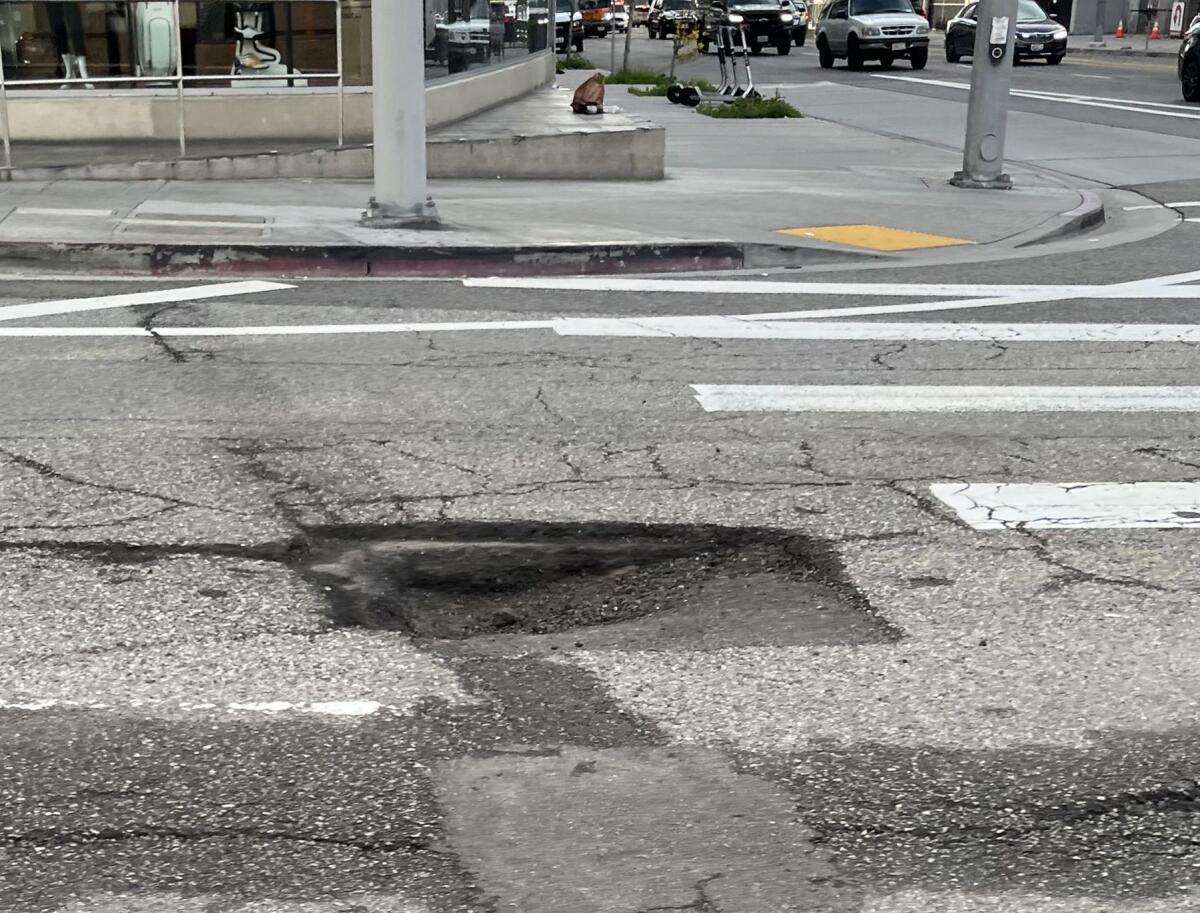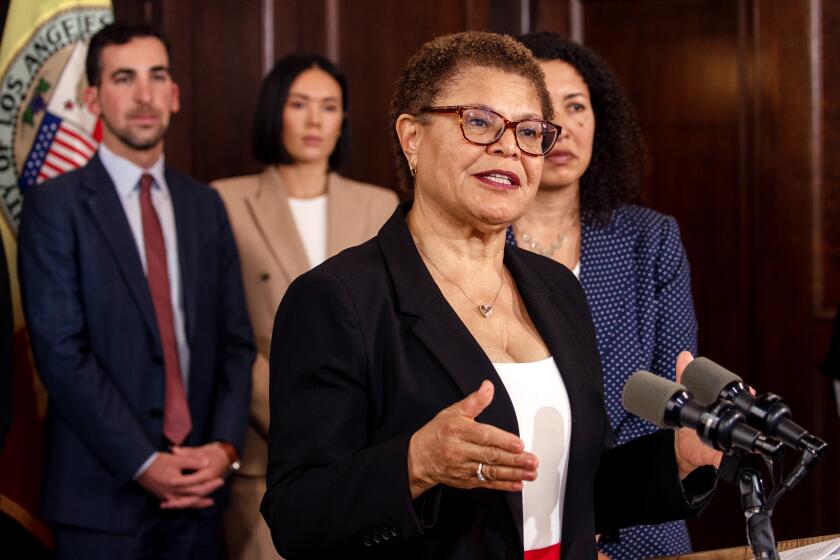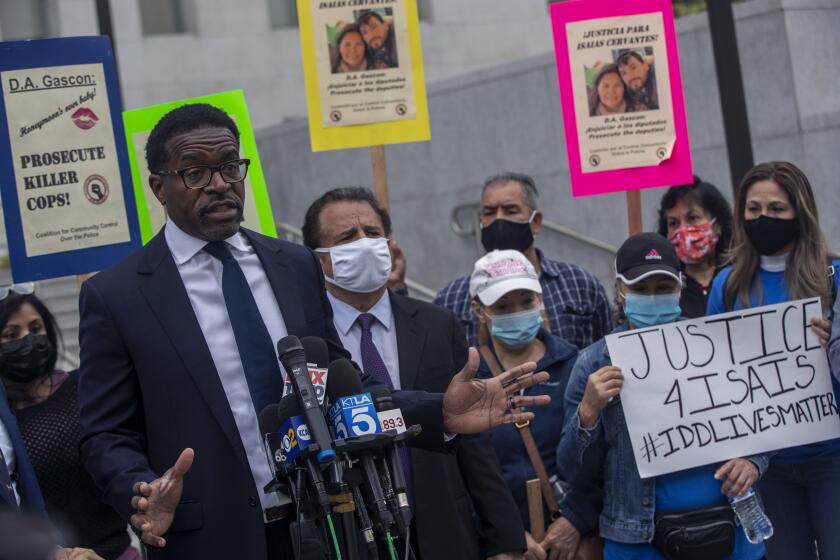Commentary: So many potholes in L.A. — and not enough people to fix them

- Share via
I was driving west on Sunset Boulevard heading to Pacific Palisades one recent Saturday afternoon, enjoying a respite from the rain, when my car was jolted by the biggest crater in the road I have ever hit. Slowly, I drove about half a mile to a full-service gas station where the attendant found a gaping hole in my right front tire, which was expelling air like a blow dryer.
Within 10 minutes of my arrival at the gas station, two other cars pulled in with ruined tires after driving over the same pothole. We compared notes on the location of this road menace (near Chautauqua Boulevard), wondered whether we could get the city to pay for damages and pulled out our cellphones in search of nearby repair shops that could fix our cars that day. Luckily, my damaged tire was a run-flat and spent its last minutes on the road getting me to Pep Boys.
This is the result of decisions made by Bass and the City Council. Now they have to be honest about their impact: service cuts, delayed construction projects and higher fees.
I’m just one of thousands of motorists in L.A. who have unknowingly steered their vehicles into a pit, especially after heavy storms. The rain turns the streets of Los Angeles into an obstacle course of potholes for drivers, motorcyclists, bicyclists and even pedestrians. More than 21 inches of rain have fallen since December, filling reservoirs and turning the hillsides a lush green, but all that water has also seeped through cracks in streets, weakening layers of asphalt. As more cars drive over it, the asphalt eventually caves in, creating potholes big and small.
If you hit a pothole, you can file a damage claim with the city to try to recoup the cost of repair. According to the city attorney’s office, 1,231 pothole damage claims were filed between September 2023 and February. (The so-called rainy season starts around December.) Only 134 were paid out for a total of $87,627.08.
California’s second straight rainy winter provided relief from years-long drought and helped Los Angeles demonstrate that it can store water for drier times. Now let’s up our drought-preparedness game.
Clearly that’s a mere drop in the rain bucket of potholes out there causing misery.
Since December 2023, the city’s Bureau of Street Services (also known as StreetsLA) received 16,709 requests for pothole repair. That includes any multiple requests. Impressively, the number the department fixed during the same period was significantly higher — 28,384.
The city searches for potholes but also relies on people reporting them — by calling 311, filling out a form on the website, https://myla311.lacity.org/ or using the MyLA311 mobile app. Important tip: Multiple reports to 311 on the same pothole will get crews out to it faster. So, the squeaky pothole gets the asphalt. On average, it takes three to four days for a crew to get to a reported pothole, officials say. I was told the pothole that demolished my tire on March 23 was fixed less than a week later.
Why can’t city workers find potholes before my car does? Sometimes they do. But it’s not possible to find and fix them all before someone runs over them. But they could do better.
Keith Mozee, the general manager of L.A. Bureau of Street Services, says workers drive 650 miles of city streets every day hunting potholes. In particular, they inspect major corridors and identify locations in need of pothole repair or other maintenance and schedule it.
But there are 7,500 miles of streets in the city of L.A. Mozee, who started his career at Street Services decades ago fixing potholes, told me a story of driving west on Sunset on his way to check out a mudslide. At the time, the portion he was on looked to be in good shape. It rained that night and the next day, his department responded to a report of a large pothole on a section of the street he had just driven. Repairing potholes is like Whac-A-Mole — there’s always another one popping up.
To get more potholes fixed quickly, Mozee says he needs more people.
Deputies’ shooting of Isaias Cervantes in his own home will probably cost Los Angeles County $25 million without spurring a change in training or tactics to prevent something similar from happening again.
The Bureau of Street Services has a whopping 388 vacant positions. Some of those are being filled through a city employment pipeline called CleanLA. Participants get training and can become employees in entry-level jobs such as fixing potholes. That’s great for both the streets and local, low-income workers who might otherwise struggle to get city jobs.
But in an effort to cut costs, the city administrative officer has proposed eliminating vacant job slots across city agencies, including 229 positions in Street Services. That’s a big chunk of jobs. I understand the city needs to cut costs but when it does, services and residents suffer. In this case, damage to vehicles is costly in time and money for owners.
We’re grateful to have the rain but the collateral damage of pockmarked streets is not just an inconvenience, it’s also a danger to the innumerable vehicles on L.A. streets. Mayor Karen Bass and the City Council need to remember that when they decide how many of the unfilled Street Services positions to whittle away — jobs that could make a difference on the road.
More to Read
A cure for the common opinion
Get thought-provoking perspectives with our weekly newsletter.
You may occasionally receive promotional content from the Los Angeles Times.














